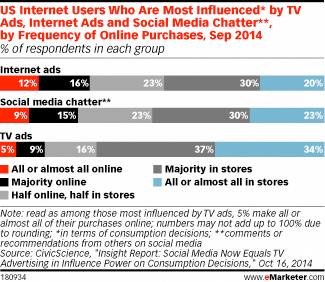Millennials’ Social Shares Don’t Stop with the Post
October 25, 2014
![]() When millennials see interesting content, they’re more likely than the general population to share it with their social networks. According to a June 2014 study by ShareThis, 25% of US millennial internet users shared digital content via social, with an average four shares per week—3.6 times and 2.1 times more than the total online population, respectively.
When millennials see interesting content, they’re more likely than the general population to share it with their social networks. According to a June 2014 study by ShareThis, 25% of US millennial internet users shared digital content via social, with an average four shares per week—3.6 times and 2.1 times more than the total online population, respectively.
 Where are millennials most likely to share? Facebook was the primary social channel used, with 55% of all content shares. But millennials were more likely than total internet users to post on other platforms, as well. For example, Twitter and Pinterest each grabbed 10% of content shares by millennials, compared with respective portions of 7% and 5% among all web users.
Where are millennials most likely to share? Facebook was the primary social channel used, with 55% of all content shares. But millennials were more likely than total internet users to post on other platforms, as well. For example, Twitter and Pinterest each grabbed 10% of content shares by millennials, compared with respective portions of 7% and 5% among all web users.
 Shares by millennials do more than take up space on friends’ feeds—they influence purchases, too. ShareThis reported that millennials were more likely than older generations to make a purchase based on content shared by one of their peers on social. Two-thirds of 18- to 34-year-olds were at least somewhat likely to do so, compared with 53% of those ages 35 to 44.
Shares by millennials do more than take up space on friends’ feeds—they influence purchases, too. ShareThis reported that millennials were more likely than older generations to make a purchase based on content shared by one of their peers on social. Two-thirds of 18- to 34-year-olds were at least somewhat likely to do so, compared with 53% of those ages 35 to 44.
Still, social comments and recommendations are becoming more influential on purchasing and consumption decisions among the digital population overall.
In September 2014 polling by CivicScience, 43% of US internet users said that social media “chatter” had the most influence on what they bought, where they ate or the movies and TV shows they watched—up 22 percentage points year over year to tie TV ads for first place. Meanwhile, just 14% said the same about internet ads. Those who were most likely to be influenced by comments or recommendations on social media were ages 18 to 29.
However, just because social influences purchases doesn’t mean those transactions take place online. In fact, CivicScience found that those influenced most by social media chatter were most likely to make the majority of their purchases in-store (30% of this group). Fully 23% split their buys between the physical and digital worlds, while the same percentage were almost completely online-only.
Courtesy of eMarketer





























